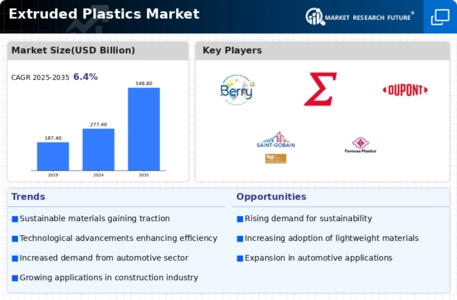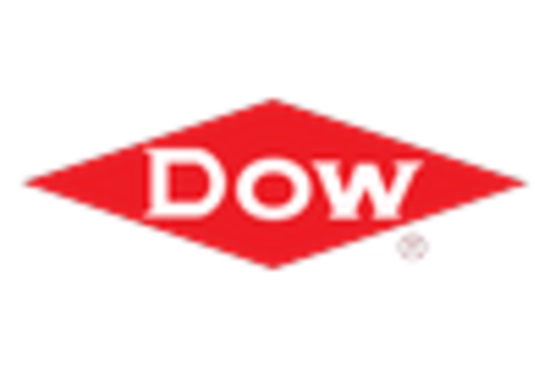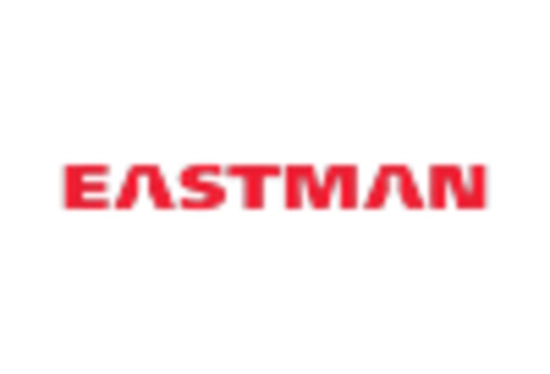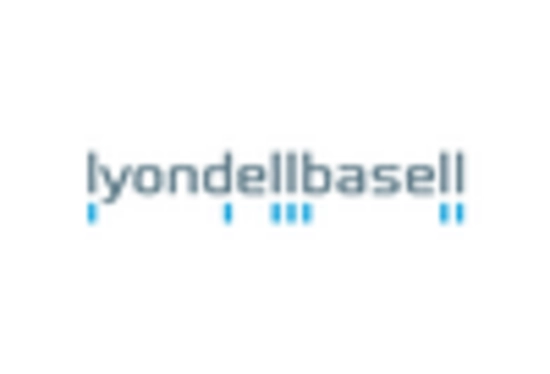-
EXECUTIVE SUMMARY 15
-
MARKET ATTRACTIVENESS ANALYSIS 17
- GLOBAL EXTRUDED PLASTICS MARKET, BY TYPE 17
- GLOBAL EXTRUDED PLASTICS MARKET, BY FORM 17
- GLOBAL EXTRUDED PLASTICS MARKET, BY END USE 18
- GLOBAL EXTRUDED PLASTICS MARKET, BY REGION 19
-
MARKET INTRODUCTION 20
-
DEFINITION 20
-
SCOPE OF THE STUDY 20
-
MARKET STRUCTURE 20
-
RESEARCH METHODOLOGY 21
-
RESEARCH PROCESS 21
-
PRIMARY RESEARCH 22
-
SECONDARY RESEARCH 23
-
MARKET SIZE ESTIMATION 23
-
TOP-DOWN AND BOTTOM-UP APPROACH 24
-
FORECAST MODEL 25
-
LIST OF ASSUMPTIONS 26
-
MARKET DYNAMICS 27
-
INTRODUCTION 27
-
DRIVERS 28
- USE OF EXTRUDED PLASTICS IN PACKAGING 28
- EXTENSIVE DEMAND FROM THE BUILDING & CONSTRUCTION INDUSTRY 28
- DRIVERS IMPACT ANALYSIS 29
-
RESTRAINT 29
- VOLATILE RAW MATERIAL PRICES 29
- REGULATORY CONSTRAINTS 31
-
OPPORTUNITY 31
- MICROBIAL DEGRADATION OF PLASTIC PRODUCTS 31
-
TRENDS 32
- ADOPTION OF SUSTAINABLE FOOD PACKAGING 32
-
MARKET FACTOR ANALYSIS 33
-
GLOBAL EXTRUDED PLASTICS INDUSTRY OUTLOOK 33
-
SUPPLY CHAIN ANALYSIS 34
- RAW MATERIALS SUPPLIERS 34
- EXTRUDED PLASTICS MANUFACTURERS 34
- DISTRIBUTION CHANNELS 35
- END USERS 35
-
PORTER’S FIVE FORCES MODEL 35
- THREAT OF NEW ENTRANTS 36
- BARGAINING POWER OF SUPPLIERS 36
- THREAT OF SUBSTITUTES 36
- BARGAINING POWER OF BUYERS 36
- INTENSITY OF RIVALRY 36
-
GLOBAL EXTRUDED PLASTICS MARKET, PRICING ANALYSIS (USD/KG) 37
-
IMPACT OF THE COVID-19 OUTBREAK ON GLOBAL EXTRUDED PLASTICS MARKET 37
- PRODUCTION SCENARIO 37
- IMPACT ON SUPPLY CHAIN 37
- IMPACT ON SALES & DISTRIBUTION 38
- IMPACT ON EXTRUDED PLASTICSEND USES 38
-
GLOBAL EXTRUDED PLASTICS MARKET, BY TYPE 39
-
OVERVIEW 39
- EXTRUDED PLASTICS: MARKET ESTIMATES & FORECAST BY TYPE, 2023–2030 40
- EXTRUDED PLASTICS: MARKET ESTIMATES & FORECAST BY TYPE, 2023–2030 40
-
LOW-DENSITY POLYETHYLENE (LDPE) 41
- LOW-DENSITY POLYETHYLENE (LDPE) MARKET ESTIMATES & FORECAST BY REGION,2023–2030 41
-
HIGH-DENSITY POLYETHYLENE (HDPE) 42
- HIGH-DENSITY POLYETHYLENE (HDPE) MARKET ESTIMATES & FORECAST BY REGION, 2023–2030 42
-
POLYPROPYLENE 43
- POLYPROPYLENEMARKET ESTIMATES & FORECAST BY REGION, 2023–2030 43
-
POLYSTYRENE 44
- POLYSTYRENEMARKET ESTIMATES & FORECAST BY REGION, 2023–2030 44
-
POLYVINYL CHLORIDE 45
- POLYVINYL CHLORIDEMARKET ESTIMATES & FORECAST BY REGION, 2023–2030 45
-
ACRYLONITRILE BUTADIENE STYRENE 46
- ACRYLONITRILE BUTADIENE STYRENEMARKET ESTIMATES & FORECAST BY REGION, 2023–2030 46
-
POLYCARBONATE 47
- POLYCARBONATEMARKET ESTIMATES & FORECAST BY REGION, 2023–2030 47
-
OTHERS 48
- OTHER EXTRUDED PLASTICSMARKET ESTIMATES & FORECAST BY REGION, 2023–2030 48
-
GLOBAL EXTRUDED PLASTICS MARKET, BY FORM 49
-
OVERVIEW 49
- EXTRUDED PLASTICS: MARKET ESTIMATES & FORECAST BY TYPE, 2023–2030 50
- EXTRUDED PLASTICS: MARKET ESTIMATES & FORECAST BY TYPE, 2023–2030 50
-
FILMS 51
- FILMSMARKET ESTIMATES & FORECAST BY REGION,2023–2030 51
-
SHEETS 52
- SHEETSMARKET ESTIMATES & FORECAST BY REGION, 2023–2030 52
-
PIPES & TUBES 53
- PIPES & TUBESMARKET ESTIMATES & FORECAST BY REGION, 2023–2030 53
-
WIRES & CABLES 54
- WIRES & CABLESMARKET ESTIMATES & FORECAST BY REGION, 2023–2030 54
-
OTHERS 55
- OTHER EXTRUDED PLASTICS MARKET ESTIMATES & FORECAST BY REGION, 2023–2030 55
-
GLOBAL EXTRUDED PLASTICS MARKET, BY END USE 56
-
OVERVIEW 56
- EXTRUDED PLASTICS: MARKET ESTIMATES & FORECAST BY END USE, 2023–2030 57
- EXTRUDED PLASTICS: MARKET ESTIMATES & FORECAST BY END USE, 2023–2030 57
-
PACKAGING 58
- PACKAGING: MARKET ESTIMATES & FORECAST BY REGION, 2023–2030 58
- PACKAGING: MARKET ESTIMATES & FORECAST BY REGION, 2023–2030 59
-
BUILDING & CONSTRUCTION 59
- BUILDING & CONSTRUCTION: MARKET ESTIMATES & FORECAST BY REGION, 2023–2030 60
- BUILDING & CONSTRUCTION: MARKET ESTIMATES & FORECAST BY REGION, 2023–2030 60
-
AUTOMOTIVE 61
- AUTOMOTIVE: MARKET ESTIMATES & FORECAST BY REGION, 2023–2030 61
- AUTOMOTIVE: MARKET ESTIMATES & FORECAST BY REGION, 2023–2030 62
-
CONSUMER GOODS 63
- CONSUMER GOODS: MARKET ESTIMATES & FORECAST BY REGION, 2023–2030 63
- CONSUMER GOODS: MARKET ESTIMATES & FORECAST BY REGION, 2023–2030 64
-
ELECTRICAL & ELECTRONICS 64
- ELECTRICAL & ELECTRONICS: MARKET ESTIMATES & FORECAST BY REGION, 2023–2030 65
- ELECTRICAL & ELECTRONICS: MARKET ESTIMATES & FORECAST BY REGION, 2023–2030 65
-
MEDICAL 66
- MEDICAL: MARKET ESTIMATES & FORECAST BY REGION, 2023–2030 66
- MEDICAL: MARKET ESTIMATES & FORECAST BY REGION, 2023–2030 67
-
OTHERS 67
- OTHERS: MARKET ESTIMATES & FORECAST BY REGION, 2023–2030 68
- OTHERS: MARKET ESTIMATES & FORECAST BY REGION, 2023–2030 68
-
GLOBAL EXTRUDED PLASTICS MARKET, BY REGION 69
-
OVERVIEW 70
-
NORTH AMERICA 71
- US 71
- CANADA 72
-
EUROPE 72
- GERMANY 73
- UK 74
- FRANCE 74
- RUSSIA 75
- SPAIN 75
- REST OF EUROPE 76
-
ASIA-PACIFIC 76
- CHINA 77
- JAPAN 77
- INDIA 78
- SOUTH KOREA 78
- AUSTRALIA & NEW ZEALAND 79
- REST OF ASIA-PACIFIC 79
-
LATIN AMERICA 81
- BRAZIL 83
- MEXICO 84
- ARGENTINA 86
- REST OF LATIN AMERICA 87
-
MIDDLE EAST & AFRICA 89
- GCC 91
- TURKEY 92
- SOUTH AFRICA 94
- REST OF MIDDLE EAST & AFRICA 95
-
COMPETITIVE LANDSCAPE 97
-
COMPETITIVEOVERVIEW 97
-
MARKET STRATEGY ANALYSIS 97
-
KEY DEVELOPMENTS 98
-
COMPETITIVE BENCHMARKING 99
-
COMPANY PROFILES 110
-
BASF SE 110
- COMPANY OVERVIEW 110
- FINANCIAL OVERVIEW 111
- PRODUCTS OFFERED 111
- KEY DEVELOPMENTS 112
- SWOT ANALYSIS 112
- KEY STRATEGIES 112
-
S H KELKAR AND COMPANY LIMITED 113
- COMPANY OVERVIEW 113
- FINANCIAL OVERVIEW 113
- PRODUCTS OFFERED 114
- KEY DEVELOPMENTS 114
- SWOT ANALYSIS 115
- KEY STRATEGIES 115
-
GIVAUDAN 116
- COMPANY OVERVIEW 116
- FINANCIAL OVERVIEW 116
- PRODUCTS OFFERED 117
- KEY DEVELOPMENTS 117
- SWOT ANALYSIS 118
- KEY STRATEGIES 118
-
KAO CORPORATION 119
- COMPANY OVERVIEW 119
- FINANCIAL OVERVIEW 119
- PRODUCTS OFFERED 111
- KEY DEVELOPMENTS 111
- SWOT ANALYSIS 111
- KEY STRATEGIES 111
-
SYMRISE 112
- COMPANY OVERVIEW 112
- FINANCIAL OVERVIEW 112
- PRODUCTS OFFERED 113
- KEY DEVELOPMENTS 113
- SWOT ANALYSIS 114
- KEY STRATEGIES 114
-
FINE CHEMICALS INC 115
- COMPANY OVERVIEW 115
- FINANCIAL OVERVIEW 115
- PRODUCTS OFFERED 115
- KEY DEVELOPMENTS 115
- SWOT ANALYSIS 116
- KEY STRATEGIES 116
-
TAKASAGO INTERNATIONAL CORPORATION 117
- COMPANY OVERVIEW 117
- TAKASAGO INTERNATIONAL CORPORATION: FINANCIAL OVERVIEW 117
- PRODUCTS OFFERED 118
- KEY DEVELOPMENTS 118
- SWOT ANALYSIS 119
- KEY STRATEGIES 119
-
INTERNATIONAL FLAVORS & FRAGRANCES 120
- COMPANY OVERVIEW 120
- INTERNATIONAL FLAVORS & FRAGRANCES: FINANCIAL OVERVIEW 120
- PRODUCTS OFFERED 121
- KEY DEVELOPMENTS 121
- SWOT ANALYSIS 121
- KEY STRATEGIES 122
-
MERCK KGAA 123
- COMPANY OVERVIEW 123
- MERCK KGAA: FINANCIAL OVERVIEW 123
- PRODUCTS OFFERED 124
- KEY DEVELOPMENTS 124
- SWOT ANALYSIS 124
- KEY STRATEGIES 124
-
SENSIENT TECHNOLOGIES 125
- COMPANY OVERVIEW 125
- FINANCIAL OVERVIEW 125
- PRODUCTS OFFERED 126
- KEY DEVELOPMENTS 126
- SWOT ANALYSIS 126
- KEY STRATEGIES 127
-
-
LIST OF TABLES
-
LIST OF ASSUMPTIONS 26
-
PRICING ANALYSIS (USD/KG) 37
-
EXTRUDED PLASTICS MARKET ESTIMATES & FORECAST, BY TYPE, 2023–2030 (USD MILLION) 40
-
EXTRUDED PLASTICS MARKET ESTIMATES & FORECAST, BY TYPE, 2023–2030 (KILO TONS) 40
-
LOW-DENSITY POLYETHYLENE (LDPE)EXTRUDED PLASTICS MARKET ESTIMATES & FORECAST, BY REGION, 2023–2030 (USD MILLION) 41
-
LOW-DENSITY POLYETHYLENE (LDPE)EXTRUDED PLASTICS STIMATES & FORECAST, BY REGION, 2023–2030 (KILO TONS) 41
-
HIGH-DENSITY POLYETHYLENE (HDPE)EXTRUDED PLASTICSS MARKET ESTIMATES & FORECAST, BY REGION, 2023–2030 (USD MILLION) 41
-
HIGH-DENSITY POLYETHYLENE (HDPE)EXTRUDED PLASTICSS MARKET ESTIMATES & FORECAST, BY REGION, 2023–2030 (KILO TONS) 42
-
POLYPROPYLENEEXTRUDED PLASTICSS MARKET ESTIMATES & FORECAST, BY REGION, 2023–2030 (USD MILLION) 42
-
POLYPROPYLENEEXTRUDED PLASTICSS MARKET ESTIMATES & FORECAST, BY REGION, 2023–2030 (KILO TONS) 42
-
POLYSTYRENE EXTRUDED PLASTICSS MARKET ESTIMATES & FORECAST, BY REGION, 2023–2030 (USD MILLION) 43
-
POLYSTYRENEEXTRUDED PLASTICSS MARKET ESTIMATES & FORECAST, BY REGION, 2023–2030 (KILO TONS) 43
-
POLYVINYL CHLORIDE EXTRUDED PLASTICSS MARKET ESTIMATES & FORECAST, BY REGION, 2023–2030 (USD MILLION) 43
-
POLYVINYL CHLORIDE EXTRUDED PLASTICSS MARKET ESTIMATES & FORECAST, BY REGION, 2023–2030 (KILO TONS) 44
-
ACRYLONITRILE BUTADIENE STYRENE EXTRUDED PLASTICSS MARKET ESTIMATES & FORECAST, BY REGION, 2023–2030 (USD MILLION) 44
-
ACRYLONITRILE BUTADIENE STYRENE EXTRUDED PLASTICSS MARKET ESTIMATES & FORECAST, BY REGION, 2023–2030 (KILO TONS) 44
-
POLYCARBONATE EXTRUDED PLASTICSS MARKET ESTIMATES & FORECAST, BY REGION, 2023–2030 (USD MILLION) 45
-
POLYCARBONATE EXTRUDED PLASTICSS MARKET ESTIMATES & FORECAST, BY REGION, 2023–2030 (KILO TONS) 45
-
OTHERSEXTRUDED PLASTICSS MARKET ESTIMATES & FORECAST, BY REGION, 2023–2030 (USD MILLION) 45
-
OTHERSEXTRUDED PLASTICSS MARKET ESTIMATES & FORECAST, BY REGION, 2023–2030 (KILO TONS) 46
-
EXTRUDED PLASTICS MARKET ESTIMATES & FORECAST, BY FORM, 2023–2030 (USD MILLION) 46
-
EXTRUDED PLASTICS MARKET ESTIMATES & FORECAST, BY FORM, 2023–2030 (KILO TONS) 46
-
FILMSMARKET ESTIMATES & FORECAST, BY REGION, 2023–2030 (USD MILLION) 47
-
FILMSMARKET ESTIMATES & FORECAST, BY REGION, 2023–2030 (MILLION SQUARE METER) 47
-
SHEETSMARKET ESTIMATES & FORECAST, BY REGION, 2023–2030 (USD MILLION) 47
-
SHEETSMARKET ESTIMATES & FORECAST, BY REGION, 2023–2030 (MILLION SQUARE METER) 48
-
PIPES & TUBESMARKET ESTIMATES & FORECAST, BY REGION, 2023–2030 (USD MILLION) 48
-
PIPES & TUBESMARKET ESTIMATES & FORECAST, BY REGION, 2023–2030 (MILLION SQUARE METER) 48
-
WIRES & CABLES MARKET ESTIMATES & FORECAST, BY REGION, 2023–2030 (USD MILLION) 49
-
WIRES & CABLES MARKET ESTIMATES & FORECAST, BY REGION, 2023–2030 (MILLION SQUARE METER) 49
-
OTHERS MARKET ESTIMATES & FORECAST, BY REGION, 2023–2030 (USD MILLION) 49
-
OTHERS MARKET ESTIMATES & FORECAST, BY REGION, 2023–2030 (MILLION SQUARE METER) 50
-
EXTRUDED PLASTICS MARKET ESTIMATES & FORECAST, BY END USE, 2023–2030 (USD MILLION) 50
-
EXTRUDED PLASTICS MARKET ESTIMATES & FORECAST, BY END USE, 2023–2030 (KILO TONS) 50
-
PACKAGING MARKET ESTIMATES & FORECAST, BY REGION, 2023–2030 (USD MILLION) 51
-
PACKAGING MARKET ESTIMATES & FORECAST, BY REGION, 2023–2030 (MILLION SQUARE METER) 51
-
BUILDING & CONSTRUCTION MARKET ESTIMATES & FORECAST, BY REGION, 2023–2030 (USD MILLION) 51
-
BUILDING & CONSTRUCTION MARKET ESTIMATES & FORECAST, BY REGION, 2023–2030 (MILLION SQUARE METER) 52
-
AUTOMOTIVE MARKET ESTIMATES & FORECAST, BY REGION, 2023–2030 (USD MILLION) 52
-
AUTOMOTIVE MARKET ESTIMATES & FORECAST, BY REGION, 2023–2030 (MILLION SQUARE METER) 52
-
CONSUMER GOODS MARKET ESTIMATES & FORECAST, BY REGION, 2023–2030 (USD MILLION) 53
-
CONSUMER GOODS MARKET ESTIMATES & FORECAST, BY REGION, 2023–2030 (MILLION SQUARE METER) 53
-
ELECTRICAL & ELECTRONICSMARKET ESTIMATES & FORECAST, BY REGION, 2023–2030 (USD MILLION) 53
-
ELECTRICAL & ELECTRONICS MARKET ESTIMATES & FORECAST, BY REGION, 2023–2030 (MILLION SQUARE METER) 54
-
MEDICAL MARKET ESTIMATES & FORECAST, BY REGION, 2023–2030 (USD MILLION) 54
-
MEDICAL MARKET ESTIMATES & FORECAST, BY REGION, 2023–2030 (MILLION SQUARE METER) 54
-
OTHERS MARKET ESTIMATES & FORECAST, BY REGION, 2023–2030 (USD MILLION) 55
-
OTHERS MARKET ESTIMATES & FORECAST, BY REGION, 2023–2030 (MILLION SQUARE METER) 55
-
GLOBAL EXTRUDED PLASTICS MARKET, BY REGION, 2023–2030 (USD MILLION) 55
-
GLOBAL EXTRUDED PLASTICS MARKET, BY REGION, 2023–2030 (KILO TONS) 56
-
NORTH AMERICA: EXTRUDED PLASTICS MARKET, BY COUNTRY, 2023–2030 (USD MILLION) 56
-
NORTH AMERICA: EXTRUDED PLASTICS MARKET, BY COUNTRY, 2023–2030 (KILO TONS) 56
-
NORTH AMERICA: EXTRUDED PLASTICS MARKET, BY TYPE, 2023–2030 (USD MILLION) 57
-
NORTH AMERICA: EXTRUDED PLASTICS MARKET, BY TYPE, 2023–2030 (KILO TONS) 57
-
NORTH AMERICA: EXTRUDED PLASTICS MARKET, BY FORM, 2023–2030 (USD MILLION) 57
-
NORTH AMERICA: EXTRUDED PLASTICS MARKET, BY FORM, 2023–2030 (KILO TONS) 58
-
NORTH AMERICA: EXTRUDED PLASTICS MARKET, BY END USE, 2023–2030 (USD MILLION) 58
-
NORTH AMERICA: EXTRUDED PLASTICS MARKET, BY END USE, 2023–2030 (KILO TONS) 58
-
US: EXTRUDED PLASTICS MARKET, BY TYPE, 2023–2030 (USD MILLION) 59
-
US: EXTRUDED PLASTICS MARKET, BY TYPE, 2023–2030 (KILO TONS) 59
-
US: EXTRUDED PLASTICS MARKET, BY FORM, 2023–2030 (USD MILLION) 59
-
US: EXTRUDED PLASTICS MARKET, BY FORM, 2023–2030 (KILO TONS) 60
-
US: EXTRUDED PLASTICS MARKET, BY END USE, 2023–2030 (USD MILLION) 60
-
US: EXTRUDED PLASTICS MARKET, BY END USE, 2023–2030 (KILO TONS) 60
-
CANADA: EXTRUDED PLASTICS MARKET, BY TYPE, 2023–2030 (USD MILLION) 61
-
CANADA: EXTRUDED PLASTICS MARKET, BY TYPE, 2023–2030 (KILO TONS) 61
-
CANADA: EXTRUDED PLASTICS MARKET, BY FORM, 2023–2030 (USD MILLION) 61
-
CANADA: EXTRUDED PLASTICS MARKET, BY FORM, 2023–2030 (KILO TONS) 62
-
CANADA: EXTRUDED PLASTICS MARKET, BY END USE, 2023–2030 (USD MILLION) 62
-
CANADA: EXTRUDED PLASTICS MARKET, BY END USE, 2023–2030 (KILO TONS) 62
-
EUROPE: EXTRUDED PLASTICS MARKET, BY COUNTRY, 2023–2030 (USD MILLION) 63
-
EUROPE: EXTRUDED PLASTICS MARKET, BY COUNTRY, 2023–2030 (KILO TONS) 63
-
EUROPE: EXTRUDED PLASTICS MARKET, BY TYPE, 2023–2030 (USD MILLION) 63
-
EUROPE: EXTRUDED PLASTICS MARKET, BY TYPE, 2023–2030 (KILO TONS) 64
-
EUROPE: EXTRUDED PLASTICS MARKET, BY FORM, 2023–2030 (USD MILLION) 64
-
EUROPE: EXTRUDED PLASTICS MARKET, BY FORM, 2023–2030 (KILO TONS) 64
-
EUROPE: EXTRUDED PLASTICS MARKET, BY END USE, 2023–2030 (USD MILLION) 65
-
EUROPE: EXTRUDED PLASTICS MARKET, BY END USE, 2023–2030 (KILO TONS) 65
-
GERMANY: EXTRUDED PLASTICS MARKET, BY TYPE, 2023–2030 (USD MILLION) 65
-
GERMANY: EXTRUDED PLASTICS MARKET, BY TYPE, 2023–2030 (KILO TONS) 66
-
GERMANY: EXTRUDED PLASTICS MARKET, BY FORM, 2023–2030 (USD MILLION) 66
-
GERMANY: EXTRUDED PLASTICS MARKET, BY FORM, 2023–2030 (KILO TONS) 66
-
GERMANY: EXTRUDED PLASTICS MARKET, BY END USE, 2023–2030 (USD MILLION) 67
-
GERMANY: EXTRUDED PLASTICS MARKET, BY END USE, 2023–2030 (KILO TONS) 67
-
UK: EXTRUDED PLASTICS MARKET, BY TYPE, 2023–2030 (USD MILLION) 67
-
UK: EXTRUDED PLASTICS MARKET, BY TYPE, 2023–2030 (KILO TONS) 68
-
UK: EXTRUDED PLASTICS MARKET, BY FORM, 2023–2030 (USD MILLION) 68
-
UK: EXTRUDED PLASTICS MARKET, BY FORM, 2023–2030 (KILO TONS) 68
-
UK: EXTRUDED PLASTICS MARKET, BY END USE, 2023–2030 (USD MILLION) 69
-
UK: EXTRUDED PLASTICS MARKET, BY END USE, 2023–2030 (KILO TONS) 69
-
FRANCE: EXTRUDED PLASTICS MARKET, BY TYPE, 2023–2030 (USD MILLION) 69
-
FRANCE: EXTRUDED PLASTICS MARKET, BY TYPE, 2023–2030 (KILO TONS) 70
-
FRANCE: EXTRUDED PLASTICS MARKET, BY FORM, 2023–2030 (USD MILLION) 70
-
FRANCE: EXTRUDED PLASTICS MARKET, BY FORM, 2023–2030 (KILO TONS) 70
-
FRANCE: EXTRUDED PLASTICS MARKET, BY END USE, 2023–2030 (USD MILLION) 71
-
FRANCE: EXTRUDED PLASTICS MARKET, BY END USE, 2023–2030 (KILO TONS) 71
-
RUSSIA: EXTRUDED PLASTICS MARKET, BY TYPE, 2023–2030 (USD MILLION) 71
-
RUSSIA: EXTRUDED PLASTICS MARKET, BY TYPE, 2023–2030 (KILO TONS) 72
-
RUSSIA: EXTRUDED PLASTICS MARKET, BY FORM, 2023–2030 (USD MILLION) 72
-
RUSSIA: EXTRUDED PLASTICS MARKET, BY FORM, 2023–2030 (KILO TONS) 72
-
RUSSIA: EXTRUDED PLASTICS MARKET, BY END USE, 2023–2030 (USD MILLION) 73
-
RUSSIA: EXTRUDED PLASTICS MARKET, BY END USE, 2023–2030 (KILO TONS) 73
-
SPAIN: EXTRUDED PLASTICS MARKET, BY TYPE, 2023–2030 (USD MILLION) 74
-
SPAIN: EXTRUDED PLASTICS MARKET, BY TYPE, 2023–2030 (KILO TONS) 74
-
SPAIN: EXTRUDED PLASTICS MARKET, BY FORM, 2023–2030 (USD MILLION) 74
-
SPAIN: EXTRUDED PLASTICS MARKET, BY FORM, 2023–2030 (KILO TONS) 75
-
SPAIN: EXTRUDED PLASTICS MARKET, BY END USE, 2023–2030 (USD MILLION) 75
-
SPAIN: EXTRUDED PLASTICS MARKET, BY END USE, 2023–2030 (KILO TONS) 75
-
REST OF EUROPE: EXTRUDED PLASTICS MARKET, BY TYPE, 2023–2030 (USD MILLION) 76
-
REST OF EUROPE: EXTRUDED PLASTICS MARKET, BY TYPE, 2023–2030 (KILO TONS) 76
-
REST OF EUROPE: EXTRUDED PLASTICS MARKET, BY FORM, 2023–2030 (USD MILLION) 76
-
REST OF EUROPE: EXTRUDED PLASTICS MARKET, BY FORM, 2023–2030 (KILO TONS) 77
-
REST OF EUROPE: EXTRUDED PLASTICS MARKET, BY END USE, 2023–2030 (USD MILLION) 77
-
REST OF EUROPE: EXTRUDED PLASTICS MARKET, BY END USE, 2023–2030 (KILO TONS) 77
-
ASIA-PACIFIC: EXTRUDED PLASTICS MARKET, BY COUNTRY, 2023–2030 (USD MILLION) 78
-
ASIA-PACIFIC: EXTRUDED PLASTICS MARKET, BY COUNTRY, 2023–2030 (KILO TONS) 78
-
ASIA-PACIFIC: EXTRUDED PLASTICS MARKET, BY TYPE, 2023–2030 (USD MILLION) 78
-
ASIA-PACIFIC: EXTRUDED PLASTICS MARKET, BY TYPE, 2023–2030 (KILO TONS) 79
-
ASIA-PACIFIC: EXTRUDED PLASTICS MARKET, BY FORM, 2023–2030 (USD MILLION) 79
-
ASIA-PACIFIC: EXTRUDED PLASTICS MARKET, BY FORM, 2023–2030 (KILO TONS) 79
-
ASIA-PACIFIC: EXTRUDED PLASTICS MARKET, BY END USE, 2023–2030 (USD MILLION) 80
-
ASIA-PACIFIC: EXTRUDED PLASTICS MARKET, BY END USE, 2023–2030 (KILO TONS) 80
-
CHINA: EXTRUDED PLASTICS MARKET, BY TYPE, 2023–2030 (USD MILLION) 80
-
CHINA: EXTRUDED PLASTICS MARKET, BY TYPE, 2023–2030 (KILO TONS) 81
-
CHINA: EXTRUDED PLASTICS MARKET, BY FORM, 2023–2030 (USD MILLION) 81
-
CHINA: EXTRUDED PLASTICS MARKET, BY FORM, 2023–2030 (KILO TONS) 81
-
CHINA: EXTRUDED PLASTICS MARKET, BY END USE, 2023–2030 (USD MILLION) 82
-
CHINA: EXTRUDED PLASTICS MARKET, BY END USE, 2023–2030 (KILO TONS) 82
-
JAPAN: EXTRUDED PLASTICS MARKET, BY TYPE, 2023–2030 (USD MILLION) 82
-
JAPAN: EXTRUDED PLASTICS MARKET, BY TYPE, 2023–2030 (KILO TONS) 83
-
JAPAN: EXTRUDED PLASTICS MARKET, BY FORM, 2023–2030 (USD MILLION) 83
-
JAPAN: EXTRUDED PLASTICS MARKET, BY FORM, 2023–2030 (KILO TONS) 83
-
JAPAN: EXTRUDED PLASTICS MARKET, BY END USE, 2023–2030 (USD MILLION) 84
-
JAPAN: EXTRUDED PLASTICS MARKET, BY END USE, 2023–2030 (KILO TONS) 84
-
INDIA: EXTRUDED PLASTICS MARKET, BY TYPE, 2023–2030 (USD MILLION) 84
-
INDIA: EXTRUDED PLASTICS MARKET, BY TYPE, 2023–2030 (KILO TONS) 85
-
INDIA: EXTRUDED PLASTICS MARKET, BY FORM, 2023–2030 (USD MILLION) 85
-
INDIA: EXTRUDED PLASTICS MARKET, BY FORM, 2023–2030 (KILO TONS) 85
-
INDIA: EXTRUDED PLASTICS MARKET, BY END USE, 2023–2030 (USD MILLION) 86
-
INDIA: EXTRUDED PLASTICS MARKET, BY END USE, 2023–2030 (KILO TONS) 86
-
SOUTH KOREA: EXTRUDED PLASTICS MARKET, BY TYPE, 2023–2030 (USD MILLION) 86
-
SOUTH KOREA: EXTRUDED PLASTICS MARKET, BY TYPE, 2023–2030 (KILO TONS) 87
-
SOUTH KOREA: EXTRUDED PLASTICS MARKET, BY FORM, 2023–2030 (USD MILLION) 87
-
SOUTH KOREA: EXTRUDED PLASTICS MARKET, BY FORM, 2023–2030 (KILO TONS) 87
-
SOUTH KOREA: EXTRUDED PLASTICS MARKET, BY END USE, 2023–2030 (USD MILLION) 88
-
SOUTH KOREA: EXTRUDED PLASTICS MARKET, BY END USE, 2023–2030 (KILO TONS) 88
-
AUSTRALIA & NEW ZEALAND: EXTRUDED PLASTICS MARKET, BY TYPE, 2023–2030 (USD MILLION) 88
-
AUSTRALIA & NEW ZEALAND: EXTRUDED PLASTICS MARKET, BY TYPE, 2023–2030 (KILO TONS) 89
-
AUSTRALIA & NEW ZEALAND: EXTRUDED PLASTICS MARKET, BY FORM, 2023–2030 (USD MILLION) 89
-
AUSTRALIA & NEW ZEALAND: EXTRUDED PLASTICS MARKET, BY FORM, 2023–2030 (KILO TONS) 89
-
AUSTRALIA & NEW ZEALAND: EXTRUDED PLASTICS MARKET, BY END USE, 2023–2030 (USD MILLION) 90
-
AUSTRALIA & NEW ZEALAND: EXTRUDED PLASTICS MARKET, BY END USE, 2023–2030 (KILO TONS) 90
-
REST OF ASIA-PACIFIC: EXTRUDED PLASTICS MARKET, BY TYPE, 2023–2030 (USD MILLION) 90
-
REST OF ASIA-PACIFIC: EXTRUDED PLASTICS MARKET, BY TYPE, 2023–2030 (KILO TONS) 91
-
REST OF ASIA-PACIFIC: EXTRUDED PLASTICS MARKET, BY FORM, 2023–2030 (USD MILLION) 91
-
REST OF ASIA-PACIFIC: EXTRUDED PLASTICS MARKET, BY FORM, 2023–2030 (KILO TONS) 91
-
REST OF ASIA-PACIFIC: EXTRUDED PLASTICS MARKET, BY END USE, 2023–2030 (USD MILLION) 92
-
REST OF ASIA-PACIFIC: EXTRUDED PLASTICS MARKET, BY END USE, 2023–2030 (KILO TONS) 92
-
LATIN AMERICA: EXTRUDED PLASTICS MARKET, BY COUNTRY, 2023–2030 (USD MILLION) 92
-
LATIN AMERICA: EXTRUDED PLASTICS MARKET, BY COUNTRY, 2023–2030 (KILO TONS) 93
-
LATIN AMERICA: EXTRUDED PLASTICS MARKET, BY TYPE, 2023–2030 (USD MILLION) 93
-
LATIN AMERICA: EXTRUDED PLASTICS MARKET, BY TYPE, 2023–2030 (KILO TONS) 94
-
LATIN AMERICA: EXTRUDED PLASTICS MARKET, BY FORM, 2023–2030 (USD MILLION) 94
-
LATIN AMERICA: EXTRUDED PLASTICS MARKET, BY FORM, 2023–2030 (KILO TONS) 94
-
LATIN AMERICA: EXTRUDED PLASTICS MARKET, BY END USE, 2023–2030 (USD MILLION) 95
-
LATIN AMERICA: EXTRUDED PLASTICS MARKET, BY END USE, 2023–2030 (KILO TONS) 95
-
BRAZIL: EXTRUDED PLASTICS MARKET, BY TYPE, 2023–2030 (USD MILLION) 95
-
BRAZIL: EXTRUDED PLASTICS MARKET, BY TYPE, 2023–2030 (KILO TONS) 96
-
BRAZIL: EXTRUDED PLASTICS MARKET, BY FORM, 2023–2030 (USD MILLION) 96
-
BRAZIL: EXTRUDED PLASTICS MARKET, BY FORM, 2023–2030 (KILO TONS) 96
-
BRAZIL: EXTRUDED PLASTICS MARKET, BY END USE, 2023–2030 (USD MILLION) 97
-
BRAZIL: EXTRUDED PLASTICS MARKET, BY END USE, 2023–2030 (KILO TONS) 97
-
MEXICO: EXTRUDED PLASTICS MARKET, BY TYPE, 2023–2030 (USD MILLION) 97
-
MEXICO: EXTRUDED PLASTICS MARKET, BY TYPE, 2023–2030 (KILO TONS) 98
-
MEXICO: EXTRUDED PLASTICS MARKET, BY FORM, 2023–2030 (USD MILLION) 98
-
MEXICO: EXTRUDED PLASTICS MARKET, BY FORM, 2023–2030 (KILO TONS) 98
-
MEXICO: EXTRUDED PLASTICS MARKET, BY END USE, 2023–2030 (USD MILLION) 99
-
MEXICO: EXTRUDED PLASTICS MARKET, BY END USE, 2023–2030 (KILO TONS) 99
-
ARGENTINA: EXTRUDED PLASTICS MARKET, BY TYPE, 2023–2030 (USD MILLION) 99
-
ARGENTINA: EXTRUDED PLASTICS MARKET, BY TYPE, 2023–2030 (KILO TONS) 100
-
ARGENTINA: EXTRUDED PLASTICS MARKET, BY FORM, 2023–2030 (USD MILLION) 100
-
ARGENTINA: EXTRUDED PLASTICS MARKET, BY FORM, 2023–2030 (KILO TONS) 100
-
ARGENTINA: EXTRUDED PLASTICS MARKET, BY END USE, 2023–2030 (USD MILLION) 101
-
ARGENTINA: EXTRUDED PLASTICS MARKET, BY END USE, 2023–2030 (KILO TONS) 101
-
REST OF LATIN AMERICA: EXTRUDED PLASTICS MARKET, BY TYPE, 2023–2030 (USD MILLION) 101
-
REST OF LATIN AMERICA: EXTRUDED PLASTICS MARKET, BY TYPE, 2023–2030 (KILO TONS) 102
-
REST OF LATIN AMERICA: EXTRUDED PLASTICS MARKET, BY FORM, 2023–2030 (USD MILLION) 102
-
REST OF LATIN AMERICA: EXTRUDED PLASTICS MARKET, BY FORM, 2023–2030 (KILO TONS) 102
-
REST OF LATIN AMERICA: EXTRUDED PLASTICS MARKET, BY END USE, 2023–2030 (USD MILLION) 103
-
REST OF LATIN AMERICA: EXTRUDED PLASTICS MARKET, BY END USE, 2023–2030 (KILO TONS) 103
-
MIDDLE EAST & AFRICA: EXTRUDED PLASTICS MARKET, BY COUNTRY, 2023–2030 (USD MILLION) 104
-
MIDDLE EAST & AFRICA: EXTRUDED PLASTICS MARKET, BY COUNTRY, 2023–2030 (KILO TONS) 104
-
MIDDLE EAST & AFRICA: EXTRUDED PLASTICS MARKET, BY TYPE, 2023–2030 (USD MILLION) 104
-
MIDDLE EAST & AFRICA: EXTRUDED PLASTICS MARKET, BY TYPE, 2023–2030 (KILO TONS) 105
-
MIDDLE EAST & AFRICA: EXTRUDED PLASTICS MARKET, BY FORM, 2023–2030 (USD MILLION) 105
-
MIDDLE EAST & AFRICA: EXTRUDED PLASTICS MARKET, BY FORM, 2023–2030 (KILO TONS) 105
-
MIDDLE EAST & AFRICA: EXTRUDED PLASTICS MARKET, BY END USE, 2023–2030 (USD MILLION) 106
-
MIDDLE EAST & AFRICA: EXTRUDED PLASTICS MARKET, BY END USE, 2023–2030 (KILO TONS) 106
-
GCC: EXTRUDED PLASTICS MARKET, BY TYPE, 2023–2030 (USD MILLION) 107
-
GCC: EXTRUDED PLASTICS MARKET, BY TYPE, 2023–2030 (KILO TONS) 107
-
GCC: EXTRUDED PLASTICS MARKET, BY FORM, 2023–2030 (USD MILLION) 107
-
GCC: EXTRUDED PLASTICS MARKET, BY FORM, 2023–2030 (KILO TONS) 108
-
GCC: EXTRUDED PLASTICS MARKET, BY END USE, 2023–2030 (USD MILLION) 108
-
GCC: EXTRUDED PLASTICS MARKET, BY END USE, 2023–2030 (KILO TONS) 108
-
TURKEY: EXTRUDED PLASTICS MARKET, BY TYPE, 2023–2030 (USD MILLION) 109
-
TURKEY: EXTRUDED PLASTICS MARKET, BY TYPE, 2023–2030 (KILO TONS) 109
-
TURKEY: EXTRUDED PLASTICS MARKET, BY FORM, 2023–2030 (USD MILLION) 109
-
TURKEY: EXTRUDED PLASTICS MARKET, BY FORM, 2023–2030 (KILO TONS) 110
-
TURKEY: EXTRUDED PLASTICS MARKET, BY END USE, 2023–2030 (USD MILLION) 110
-
TURKEY: EXTRUDED PLASTICS MARKET, BY END USE, 2023–2030 (KILO TONS) 110
-
SOUTH AFRICA: EXTRUDED PLASTICS MARKET, BY TYPE, 2023–2030 (USD MILLION) 111
-
SOUTH AFRICA: EXTRUDED PLASTICS MARKET, BY TYPE, 2023–2030 (KILO TONS) 111
-
SOUTH AFRICA: EXTRUDED PLASTICS MARKET, BY FORM, 2023–2030 (USD MILLION) 111
-
SOUTH AFRICA: EXTRUDED PLASTICS MARKET, BY FORM, 2023–2030 (KILO TONS) 112
-
SOUTH AFRICA: EXTRUDED PLASTICS MARKET, BY END USE, 2023–2030 (USD MILLION) 112
-
SOUTH AFRICA: EXTRUDED PLASTICS MARKET, BY END USE, 2023–2030 (KILO TONS) 112
-
REST OF MIDDLE EAST & AFRICA: EXTRUDED PLASTICS MARKET, BY TYPE, 2023–2030 (USD MILLION) 113
-
REST OF MIDDLE EAST & AFRICA: EXTRUDED PLASTICS MARKET, BY TYPE, 2023–2030 (KILO TONS) 113
-
REST OF MIDDLE EAST & AFRICA: EXTRUDED PLASTICS MARKET, BY FORM, 2023–2030 (USD MILLION) 113
-
REST OF MIDDLE EAST & AFRICA: EXTRUDED PLASTICS MARKET, BY FORM, 2023–2030 (KILO TONS) 114
-
REST OF MIDDLE EAST & AFRICA: EXTRUDED PLASTICS MARKET, BY END USE, 2023–2030 (USD MILLION) 114
-
REST OF MIDDLE EAST & AFRICA: EXTRUDED PLASTICS MARKET, BY END USE, 2023–2030 (KILO TONS) 114
-
KEY DEVELOPMENTS 115
-
AMCOR PLC: PRODUCTS OFFERED 115
-
BERRY GLOBAL INC.: PRODUCTS OFFERED 115
-
SAUDI BASIC INDUSTRIES CORPORATION (SABIC): PRODUCTS OFFERED 117
-
SAUDI BASIC INDUSTRIES CORPORATION (SABIC): KEY DEVELOPMENTS 117
-
DUPONT DE NEMOURS, INC.: PRODUCTS OFFERED 111
-
EXXON MOBIL CORPORATION PRODUCTS OFFERED 113
-
EXXON MOBIL CORPORATION: KEY DEVELOPMENTS 113
-
SAINT-GOBAIN: PRODUCTS OFFERED 115
-
FORMOSA PLASTICS CORPORATION: PRODUCTS OFFERED 118
-
CHEVRON PHILLIPS CHEMICAL COMPANY: PRODUCTS OFFERED 121
-
ATLANTIS PLASTICS, INC.: PRODUCTS OFFERED 124
-
SIGMA PLASTICS GROUP: PRODUCTS OFFERED 126
-
SIGMA PLASTICS GROUP: KEY DEVELOPMENTS 126
-
-
LIST OF FIGURES
-
MARKET SYNOPSIS 16
-
GLOBAL EXTRUDED PLASTICS MARKET ANALYSIS BY TYPE, 2019 17
-
GLOBAL EXTRUDED PLASTICS MARKET ANALYSIS BY FORM, 2019 17
-
GLOBAL EXTRUDED PLASTICS MARKET ANALYSIS BY END USE, 2019 18
-
GLOBAL EXTRUDED PLASTICS MARKET ANALYSIS BY REGION 19
-
GLOBAL EXTRUDED PLASTICS MARKET: MARKET STRUCTURE 20
-
RESEARCH PROCESS OF MRFR 21
-
MARKET DYNAMICS OF THE GLOBAL EXTRUDED PLASTICS MARKET 27
-
GLOBAL PACKAGING INDUSTRY, 2015–2023 28
-
DRIVERS IMPACT ANALYSIS: GLOBAL EXTRUDED PLASTICS MARKET 29
-
CRUDE OIL PRICES USD PER BARREL (2014–2019) 30









Leave a Comment